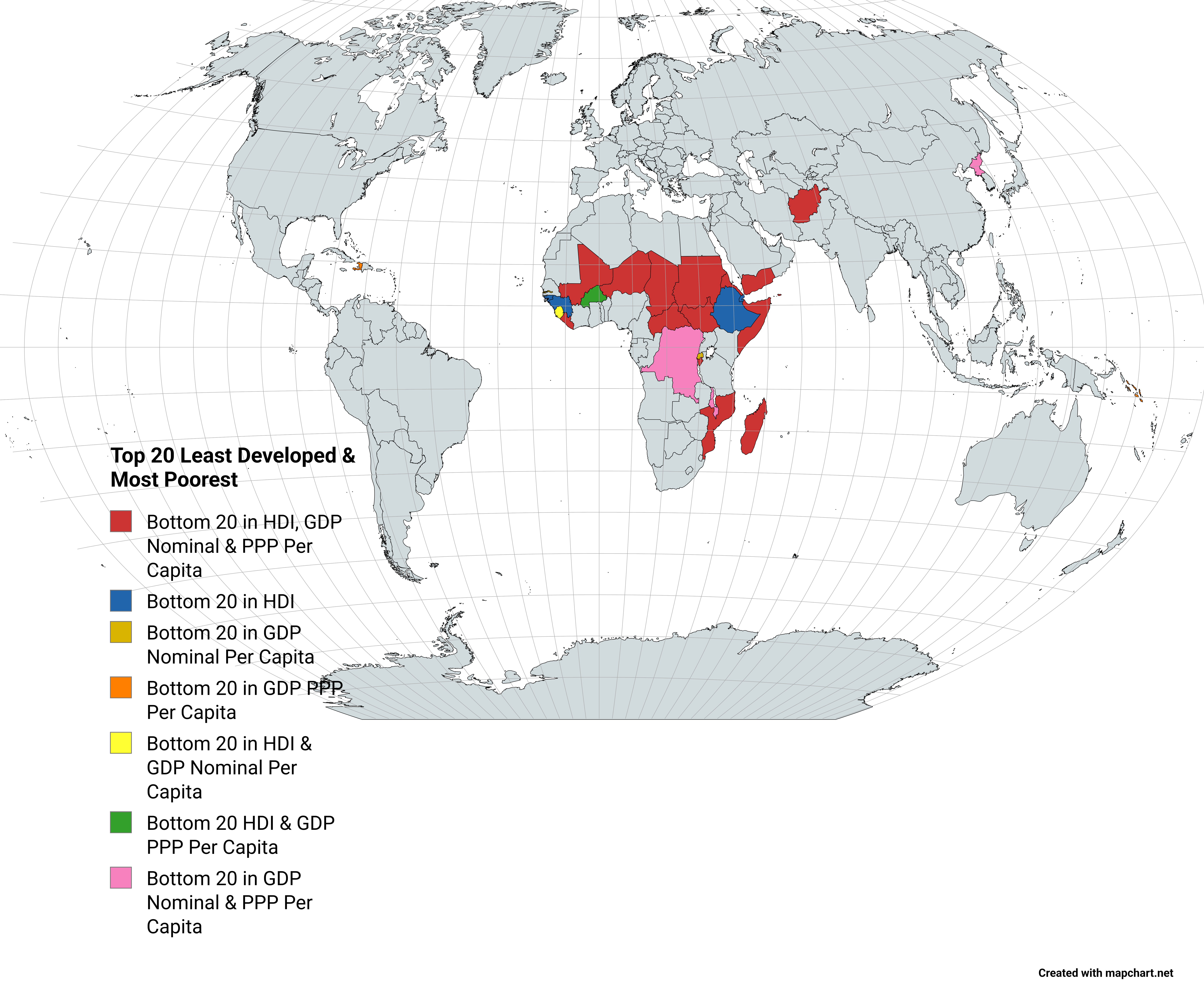Least Developed and Poorest Countries Map


David Chen
Data Visualization Specialist
David Chen is an expert in transforming complex geographic datasets into compelling visual narratives. He combines his background in computer science ...
Geographic Analysis
What This Map Shows
The "Top 20 Least Developed & Most Poorest Countries" map visually illustrates the economic and social challenges faced by nations that are classified as least developed. This classification is based on a combination of factors, including income levels, human assets, and economic vulnerability. The map serves as a stark reminder of the inequalities that exist globally, highlighting regions where poverty remains pervasive and development is significantly hampered.
Deep Dive into Least Developed Countries
Least developed countries (LDCs) are defined by the United Nations based on specific criteria that assess their economic and social conditions. These countries typically feature low gross national income (GNI) per capita, limited human development indicators such as education and health, and are often vulnerable to external shocks like climate change and economic volatility.
Interestingly, as of 2023, the majority of the countries on this list are located in sub-Saharan Africa, with a few exceptions in South Asia and the Pacific. For instance, countries like Burundi, South Sudan, and Malawi are prominently featured due to their low GNI per capita, which often falls below $1,000. Have you noticed how these economic figures reflect a larger narrative of struggle against poverty?
In terms of human development, factors like life expectancy, access to clean water, and education levels paint a grim picture. Many LDCs experience life expectancies below 60 years, primarily due to inadequate healthcare systems and high rates of infectious diseases. Furthermore, literacy rates in these countries are often significantly lower than the global average, creating a cycle of poverty that is hard to break.
Another key aspect is economic vulnerability. LDCs often rely heavily on agriculture, which makes them susceptible to fluctuations in global commodity prices and climate change impacts. For example, regions experiencing droughts or floods see immediate consequences on food security, which exacerbates poverty levels. What’s fascinating is that while these countries are rich in natural resources, the benefits rarely trickle down to the local populations. Instead, wealth tends to be extracted, leaving communities impoverished.
Regional Analysis
When analyzing the regions represented in the map, a clear pattern emerges. Sub-Saharan Africa dominates the list, with nations like Niger, Madagascar, and Mozambique grappling with poverty. For instance, Niger has faced significant challenges due to desertification and political instability, making development efforts particularly difficult. Conversely, Bangladesh, while classified as one of the poorest nations, shows signs of economic growth and development, showcasing that progress is possible even under challenging circumstances.
In the Pacific, countries like Tuvalu and Solomon Islands face unique challenges due to their geographic isolation. Their economies are often small and dependent on limited industries, which can be easily disrupted by global economic shifts. In contrast, South Asian countries like Afghanistan struggle with prolonged conflict and humanitarian crises, which severely undermine any potential for development.
Interestingly, while these regions are often painted with a broad brush of poverty, there are pockets of resilience. For example, Rwanda, once labeled as one of the poorest countries post-genocide, has made substantial strides in economic development and social stability, serving as a case study for potential transformation.
Significance and Impact
Understanding the situation of the least developed and poorest countries is crucial for a variety of reasons. Firstly, it highlights global inequality and the necessity for targeted international aid and development programs. These nations often require assistance to build infrastructure, improve education, and provide basic health services. Without this support, the cycle of poverty is likely to perpetuate.
Moreover, as our world becomes increasingly interconnected, the implications of instability in these regions can have far-reaching effects. For instance, mass migrations driven by poverty and conflict can lead to political and social tensions in neighboring countries and beyond. Additionally, global issues like climate change disproportionately affect these nations, making international cooperation essential for sustainable development.
Looking ahead, future projections indicate that if current trends continue, the gap between developed and least developed countries may widen, especially as climate change impacts become more pronounced. However, there's hope; with concerted efforts from governments, NGOs, and international organizations, significant change is achievable. Have you considered how your actions and awareness can contribute to this global issue? Every step towards understanding and addressing these challenges can make a difference.
Visualization Details
- Published
- August 7, 2025
- Views
- 136
Comments
Loading comments...